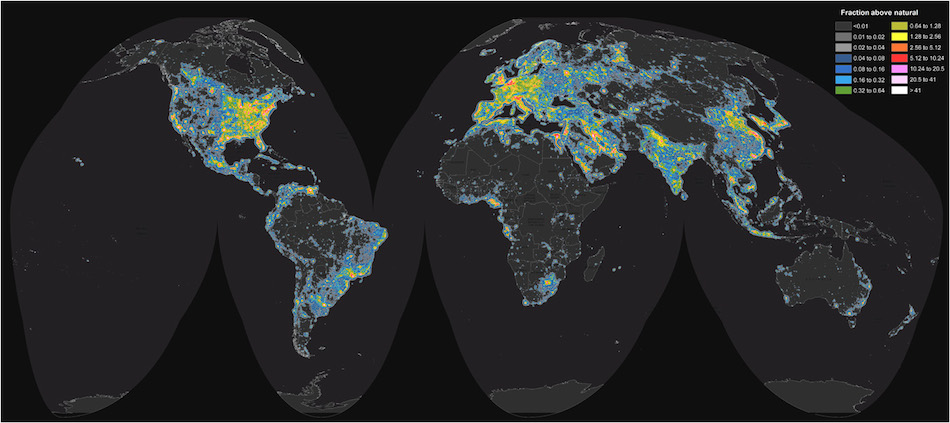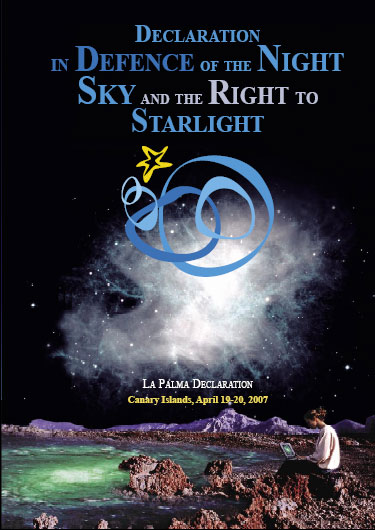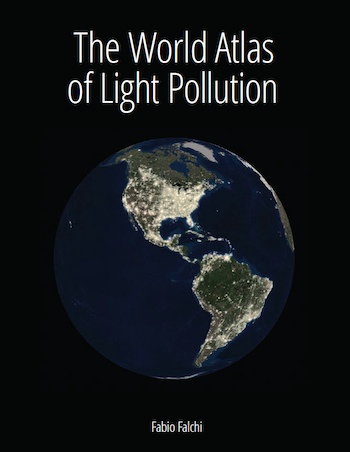The New World Atlas of Light Pollution - Paperback
The first book that shows the spread of light pollution on our planet
By Fabio Falchi (Author), Paul Bogard (Preface), Cipriano Marin (Contributor)
Published with the support of: ISTIL (Light Pollution Science and Technology Institute), CieloBuio and Starlight Initiative in partnership with UNESCO's MaB Programme.
The Light Pollution World Atlas is the most powerful tool to raise awareness about the impact of this type of pollution around the world. The new version is a major breakthrough in enabling people, governments, local authorities, researchers and industry to face this global challenge. After fifteen years, the second atlas shows a significant increase of artificial sky brightness over time and continents. We are facing the degradation of a legacy with strong cultural, scientific, environmental, aesthetic and healthy repercussions. Now is the time to act.
The book is the result of years of research by the author and his collaborators. The book contains full color plates of the continents and of the main countries, showing the brightness of the night sky at zenith due to light pollution. It can help to choose the best places for stargazing or the nearest site to admire the Milky Way. It will show how polluted is the place where you live. The book also describe how to reduce light pollution and its negative consequences on economy, environment and human health. Beside all this, the spectacular plates it presents are a call to action to preserve the last naturally dark places on our planet and to restore the night as it has been for billion years.
Publication available on Amazon
Link
Light pollution and skyglow
Artificial lights raise night sky luminance, creating the most visible effect of light pollution—artificial skyglow. Despite the increasing interest among scientists in fields such as ecology, astronomy, health care, and land-use planning, light pollution lacks a current quantification of its magnitude on a global scale. To overcome this, we present the world atlas of artificial sky luminance, computed with our light pollution propagation software using new high-resolution satellite data and new precision sky brightness measurements. This atlas shows that more than 80% of the world and more than 99% of the U.S. and European populations live under light-polluted skies. The Milky Way is hidden from more than one-third of humanity, including 60% of Europeans and nearly 80% of North Americans. Moreover, 23% of the world’s land surfaces between 75°N and 60°S, 88% of Europe, and almost half of the United States experience light-polluted nights.

World map of artificial sky brightness. The map shows, in two fold increasing steps, the artificial sky brightness as a ratio to the natural sky brightness (assumed to be 174 μcd/m2). © Fabio Falchi, Pierantonio Cinzano, Dan Duriscoe, Christopher C. M. Kyba, Christopher D. Elvidge, Kimberly Baugh, Boris A. Portnov, Nataliya A. Rybnikova and Riccardo Furgoni.
Access to ESRI map - generated by CIRES
Check out the globe version of the atlas, too (not compatible with Chrome) in CIRES
Paving the way towards a new lighting culture
The skies, which have been, and are, an inspiration to all humanity, are becoming obscured and even unknown to the younger generation. An essential element of our civilisation and culture is rapidly becoming lost, and this loss will affect all countries on Earth. The increase in light pollution is blotting out the stars from our sky, causing the deterioration of a legacy with strong cultural, scientific, environmental and aesthetic impacts.
The over-illumination has become a growing phenomenon in many towns and cities around the world. Inefficiency and excess of artificial light increases energy consumption and it is economically unjustified. It also increases the level of emissions that contribute to climate change. By contrast, today more than 1.3 billion people worldwide lack access to electricity.
The reduction of light pollution, energy savings and the recovery of the starry sky,should be an integral part of a new lighting culture committed to the climate and the sustainable development. Today there is sufficient knowledge and competitive technology available to guarantee a proper use of outdoor lighting causing much less light pollution. Nowadays, we also witness the appearance of intelligent lighting. Therefore, the big challenge is to acknowledge the problem and to act accordingly.
In this context, the Light Pollution World Atlas is a powerful tool for the governments, international organizations, lighting industry, local authorities and the people themselves to be able to face this problem jointly. It also allows to know the excess of light pollution in each region and to identify the areas where urgent action should be taken.
Governments have committed themselves in the Paris Agreement of 2015 to takeeffective measures against climate change. Thus, it should be recalled that the lighting represents more than 15% of the worldwide consumption of electricity and contributes about 6% to the overall level of greenhouse gas emissions. Outdoor lighting represents a significant part of this consumption. In these circumstances, there is an urgent need from the governments to develop specific policies which allow to progress towards a clean and low-carbon lighting, especially bearing in mind the current state of the lighting systems. Around 500 million outdoor lighting luminaires are installed all over the world and most of them are more than twenty years old and do not meet current energy efficiency and environmental criteria.
International organisations play an important role when uniting wills and promoting actions with the participation of the main stakeholders. For this reason, and bearing in mind the importance of these challenges, sustainable and intelligent lighting have been considered a key objective in the current United Nations Decade of Sustainable Energy for All (2014-2024).
It is necessary to recall that most of the agencies of the United Nations system, with the leadership of the UNESCO, the IAC and the MaB Programme, supported in 2007 the Starlight Declaration, which urges in one of its resolutions to maintain systems for monitoring light pollution, mentioning specifically the need to keep permanently updated the Light Pollution World Atlas.
The reduction of the light pollution and its monitoring are being progressively incorporated to the policies of conservation and sustainable development in many places, and, in particular, in the UNESCO sites. Nowadays, more than 40 territories, including biosphere reserves, world heritage sites and geoparks, have adopted certifications and responsible initiatives of outdoor lighting. Throughout this time, the first atlas, same as this second edition will do, has provided a key reference when incorporating the dimension of the dark skies in the management of protected areas and the protection of biodiversity at night.
However, the great cultural change in lighting will be attributable to the local administrations committed to the defense of the quality of life of the citizens and to its capacity to generate ordinances, by-laws and initiatives regulating light pollution. The current Atlas provides also an educational resource and a mobilization weapon of extraordinary value, which will contribute to raise awareness of the right to recover the legacy of the starry sky and to claim the establishment of a new lighting culture non aggressive for human health and environment.
Whereas air, noise, or water pollution have been high priority policy issues for decades, light pollution remains scientifically, culturally, and institutionally in the dark. The possibility of change is in our hands and this second atlas shows us the urgent need to act accordingly.
(*) About the Author: Fabio Falchi, physicist, works on light pollution for more than 20 years now. He is one of the authors of the First Atlas of Artificial Night Sky Brightness, published in 2001 on the Monthly Notices of the Royal Astronomical Society, and leaded the group of scientists that produced the New World Atlas, published on Science Advances by the American Association for the Advancement of Science. More information in Siences Advances.
| Next > |
|---|
LOOKING FOR SOMETHING?


Starlight Initiative collaborates with the
PORTAL TO THE HERITAGE OF ASTRONOMYUpdates
- The New World Atlas of Light Pollution - Paperback
- Starlight, beyond light pollution - La Palma 2016
- New Brochure of UNESCO`s MAB Programme partnership
- Galicia adopts the Starlight Declaration
- Starlight at the 39th session of the World Heritage Committee
- International declaration warning about the effects of blue-rich white light
- Flyer - Starlight Initiative in partnership with the UNESCO MAB Programme
- Astronomical Heritage - Hawaii 2015
Starlight Finder
Starlight related links
![]()
Covenant of Mayors Related Initiative
![]()
Colaborating with IAU Working Group
![]()
IUCN Dark Sky Advisory Group
![]()
Dark Skies Awareness Project
![]()
Partnership Unesco-MaB
![]()
Member of the Knowledge Network
![]()
Instituto de Astrofísica de Canarias
|
The Starlight Initiative is designed as an international action in defence of the values associated with the night sky and the general right to observe the stars. It is open to the participation of all scientific, cultural, environmental, and citizens' organizations... |
In partnership with: |
|
|
|



